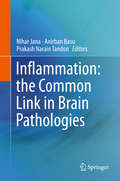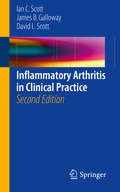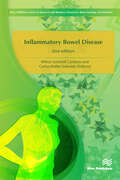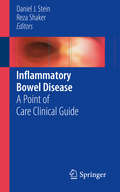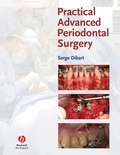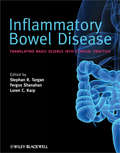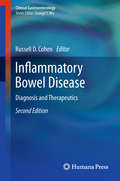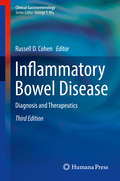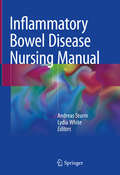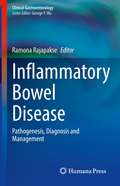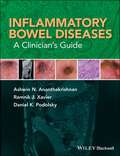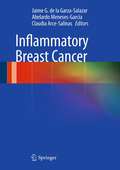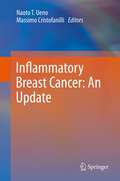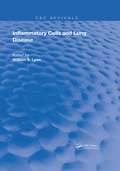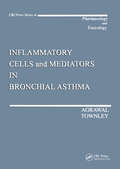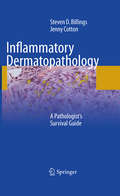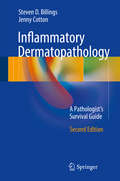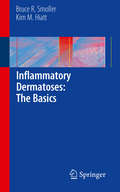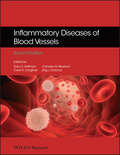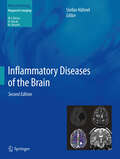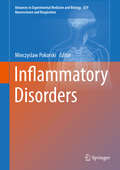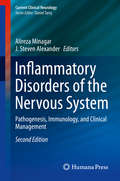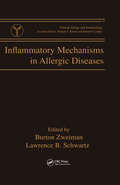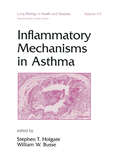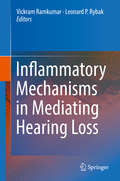- Table View
- List View
Inflammation: the Common Link in Brain Pathologies
by Nihar Jana Anirban Basu Prakash Narain TandonThis unifying theme of this book-with sections on mechanisms of defense and neuropathogenesis, neurological diseases, infections of the nervous system, neuropharmacology, and novel therapies-is interactions of the immune and nervous systems. It also discusses the role of inflammation as a key mediator of different brain disorders. There have been significant scientific advances in the multidisciplinary field of neuroimmunology / neuroinflammation in the past decade, and this book, edited under the guidance of Professor P. N. Tandon, fosters communication between those who share an interest in this exciting area, including neuroscientists, immunologists, cell biologists, clinicians and neuropharmacologists.
Inflammatory Arthritis in Clinical Practice
by David L. Scott Ian C. Scott James B. GallowayUnderstanding the key components of the diagnosis, assessment and management of inflammatory arthritis patients is essential to improving patient care. This book aims to cover these areas. It places inflammatory arthritis into a historical context; deals with the epidemiology, pathology, clinical assessment and investigation of inflammatory arthritis patients and provides a comprehensive overview of currently available treatment options. It provides insight into stratified medicine, an area of emerging importance in the management of heterogeneous diseases like RA. Finally, it provides an overview of what treatments strategies are in development.
Inflammatory Bowel Disease
by Wilton Schmidt Cardozo Carlos Walter SobradoInflammatory Bowel Disease, 2nd edition presents updated information about inflammatory bowel disease in health-care workers. The theoretical content is based on controlled and randomized clinical studies in the meta-analyzes, conducted appropriately and especially in global consensus and led by international experts. As such, the reader has access the important topics required to understand the ulcerative colitis and Crohn's disease.The editors and chapter authors, all established names within gastroenterology and coloproctology, and having extensive experience in assisting patients with inflammatory bowel disease, provide a concise book with quick and objective reference texts that complement the knowledge of students, doctors, nurses, nutritionists and psychologists of daily clinical practice.
Inflammatory Bowel Disease
by Reza Shaker Daniel J. SteinThis title provides a point-of-care reference for busy clinicians who need the best evidence based answers to patient questions at their fingertips. Additionally, it guides clinicians through the complicated therapeutic management of IBD including drug initiation, medications side effects and complications, therapeutic level monitoring and accurate disease monitoring. Lastly, it addresses special situations such as alternative therapies, pregnancy, fertility, and lactation. Inflammatory Bowel Disease: A Point-of-Care Reference Guide will be a valuable reference for Gastroenterologists, Gastroenterology Fellows and Mid-Level Providers.
Inflammatory Bowel Disease
by Serge Dibart DmdPractical Advanced Periodontal Surgery offers a step-by-step guide to cutting-edge surgical techniques as well as interdisciplinary treatment approaches in periodontology. It details procedures in a practical, succinct, thorough and accessible way, profiling more complex and advanced procedures, through a user-friendly and highly visual format. By presenting an innovative approach to each treatment modality, Practical Advanced Periodontal Surgery provides predictable solutions to complex daily dental challenges.
Inflammatory Bowel Disease
by Fergus Shanahan Stephan R. Targan Loren C. KarpThis is the state-of-the-art book on inflammatory bowel disease you have been waiting forWritten and edited by international experts in gastroenterology this up-to-date volume provides a complete review of the basic science behind inflammatory bowel disease (IBD), as well as evidence-based clinical guidance on diagnosis, treatment and long-term management of IBD.In 50 chapters the authors cover the latest and most promising treatment modalities and the science behind them. There are chapters which cover the advances in the medical and surgical treatment of conditions such as Crohn's disease and ulcerative colitis, as well as chapters focusing on nutrition, imaging and complementary medicine.This is an invaluable information resource for all those in the medical team treating patients with IBD. Whether you are a gastroenterologist, gastrointestinal surgeon or GI nurse specialist this book deserves a place in your library.
Inflammatory Bowel Disease
by Russell D. CohenAs in the first edition of Inflammatory Bowel Diseases this new edition continues to provide readers with a concise, yet in-depth review of many of the important areas in the history, epidemiology, pathogenesis, diagnosis, and treatment of the inflammatory bowel diseases (ulcerative colitis and Crohn's disease), as well as associated issues: extraintestinal manifestations, ostomy care, women's issues, economics, etc. This Second Edition provides the reders with up-to-date, state-of-the art approaches to these disease states, with expansion into the newer topics that have emerged in the past few years which include the expansion of biological agents for treatment, new studies in the epidemiology of IBD, the changing economics of IBD, breakthroughs in new endoscopic evaluations, major advances in novel radiographic techniques, the detection of colorectal cancer in patients with IBD and new findings in the genetics of IBD. New Trend / Developments (* These all emerged since our last edition) The most critical trend that has arisen over the past few years has been the introduction and expansion of biological agents in the treatment of inflammatory diseases worldwide. While only one agent, infliximab (Remicade), existed at the time of publication of my first edition, there have been multiple other agents either approved or pending approval for the treatments of these diseases, or in the upper-stages of development. The impact is not only upon the patients, but also on the health-care providers, policy makers, researchers, biotech and pharmacompanies, and the business community. Major changes worldwide in the epidemiology of IBD has spurred new studies in the demographics of who is getting these diseases and why. Previously characterized as diseases primarily affected Caucasians in industrialized countries, there has been an explosion of growth amongst the African American and Hispanic populations in the United States, and well as in pockets of these and other ethnic groups worldwide. The economics of IBD has been changing greatly, given the issues raised above, as well as major changes in the United States Medicare program, and other insurance changes. The growing proportion of the GNP that healthcare costs are consuming in the US and worldwide has shifted attention to decreasing utilization of health care services, and other cost-savings measures. Again, up to this point this has been an exclusive part of our IBD book. New findings in the genetics of IBD have been recently published. Our first edition had the finding of the first Crohn's disease gene inserted just before going to press; so much has been published about the phenotypes and other genotypes that have emerged. Breakthroughs in new endoscopic evaluations of the bowel (ie. Capsule endoscopy, double-balloon enteroscopy, endoscopic ultrasound) and their use in the inflammatory bowel diseases will be a key highlight of this new book. Major advances in novel radiographic techniques employed in patients with inflammatory bowel disease (ie. CT enterography, MR enterography, advanced ultrasounds, etc.) will also an important component of our work. There have been numerous areas related to the development and detection of colorectal cancer in patients with IBD that have emerged in the past few years. Techniques of better detection (ie. Narrow band imaging; special mucosal staining; endoscopic histological evaluations) as well as research in the putative role of mesalamine and other agents for colorectal cancer prevention are all hot topics that will attract much interest from a variety of interest groups I described above. Identification of additional disease states that probably belong in the IBD family, such as microscopic colitis (including lymphocytic colitis), and collagenous colitis add to the diseases that will be discussed in this new edition.
Inflammatory Bowel Disease
by Russell D. CohenAs in the first edition of Inflammatory Bowel Diseases this new edition continues to provide readers with a concise, yet in-depth review of many of the important areas in the history, epidemiology, pathogenesis, diagnosis, and treatment of the inflammatory bowel diseases (ulcerative colitis and Crohn's disease), as well as associated issues: extraintestinal manifestations, ostomy care, women's issues, economics, etc. This Second Edition provides the reders with up-to-date, state-of-the art approaches to these disease states, with expansion into the newer topics that have emerged in the past few years which include the expansion of biological agents for treatment, new studies in the epidemiology of IBD, the changing economics of IBD, breakthroughs in new endoscopic evaluations, major advances in novel radiographic techniques, the detection of colorectal cancer in patients with IBD and new findings in the genetics of IBD. New Trend / Developments (* These all emerged since our last edition) The most critical trend that has arisen over the past few years has been the introduction and expansion of biological agents in the treatment of inflammatory diseases worldwide. While only one agent, infliximab (Remicade), existed at the time of publication of my first edition, there have been multiple other agents either approved or pending approval for the treatments of these diseases, or in the upper-stages of development. The impact is not only upon the patients, but also on the health-care providers, policy makers, researchers, biotech and pharmacompanies, and the business community. Major changes worldwide in the epidemiology of IBD has spurred new studies in the demographics of who is getting these diseases and why. Previously characterized as diseases primarily affected Caucasians in industrialized countries, there has been an explosion of growth amongst the African American and Hispanic populations in the United States, and well as in pockets of these and other ethnic groups worldwide. The economics of IBD has been changing greatly, given the issues raised above, as well as major changes in the United States Medicare program, and other insurance changes. The growing proportion of the GNP that healthcare costs are consuming in the US and worldwide has shifted attention to decreasing utilization of health care services, and other cost-savings measures. Again, up to this point this has been an exclusive part of our IBD book. New findings in the genetics of IBD have been recently published. Our first edition had the finding of the first Crohn's disease gene inserted just before going to press; so much has been published about the phenotypes and other genotypes that have emerged. Breakthroughs in new endoscopic evaluations of the bowel (ie. Capsule endoscopy, double-balloon enteroscopy, endoscopic ultrasound) and their use in the inflammatory bowel diseases will be a key highlight of this new book. Major advances in novel radiographic techniques employed in patients with inflammatory bowel disease (ie. CT enterography, MR enterography, advanced ultrasounds, etc. ) will also an important component of our work. There have been numerous areas related to the development and detection of colorectal cancer in patients with IBD that have emerged in the past few years. Techniques of better detection (ie. Narrow band imaging; special mucosal staining; endoscopic histological evaluations) as well as research in the putative role of mesalamine and other agents for colorectal cancer prevention are all hot topics that will attract much interest from a variety of interest groups I described above. Identification of additional disease states that probably belong in the IBD family, such as microscopic colitis (including lymphocytic colitis), and collagenous colitis add to the diseases that will be discussed in this new edition.
Inflammatory Bowel Disease Nursing Manual
by Andreas Sturm Lydia WhiteThis comprehensive manual discusses the many aspects of inflammatory bowel disease (IBD), providing relevant information along with practical guidance. The reader is also directed to additional resources for extra and current information. This book comes at a time when the number of people suffering from the two major forms of IBD, ulcerative colitis (UC) and Crohn’s disease (CD), is rising around the globe. Despite their huge impact on daily life and health economics, these diseases are not fully understood, and diagnosis and treatment remains a significant challenge. IBD nurses are increasingly recognised as key clinicians within the multidisciplinary team caring for people with IBD. Through experience and specialist knowledge IBD nurses provide timely support, advice, and treatment for people living with this unpredictable condition. IBD nurses are also well placed to liaise with the wider team, developing patient centred services which best fit their local health framework. The combined international expertise and accessible guidance here will equip nurses, or any clinician wanting to increase their competence in IBD management. Thereby this manual aims to contribute to the optimisation of IBD care throughout the world.
Inflammatory Bowel Disease: Pathogenesis, Diagnosis and Management (Clinical Gastroenterology)
by Ramona RajapakseThis book uses new thinking on precision medicine and the interplay of genetic factors, the microbiome, and external triggers to build on the core concepts of inflammatory bowel disease. It outlines the latest findings in targeting therapies to the individual patient with Crohn’s and colitis, management of chronic infections in the setting of immunomodulators and biologics, non-surgical therapy of dysplasia in colitis patients, and redefining and structuring the problematic pouch. In addition, this book features useful chapters dedicated to the economic aspects of IBD in an increasingly constrained healthcare system, as well as the patient experience and the role of subspecialist telemedicine care.Written by specialists and thought leaders in the field, Inflammatory Bowel Disease: Pathogenesis, Diagnosis and Management provides a concise but highly relevant account of the latest thinking and concepts in IBD.
Inflammatory Bowel Diseases: A Clinician's Guide
by Daniel K. Podolsky Ashwin N. Ananthakrishnan Ramnik J. XavierInflammatory Bowel Diseases: A Clinician’s Guide provides practical guidance for the diagnosis and management of those suspected or known to have one of the forms of these complex diseases. It is perfect both for gastroenterology trainees learning to care for these patients and the experienced physician as a concise and practical resource for day to day use. Written by the experts, Inflammatory Bowel Diseases: A Clinician’s Guide is an essential tool for all gastroenterologists managing patients with inflammatory bowel disease.
Inflammatory Breast Cancer
by Jaime G. de la Garza-Salazar Claudia Arce-Salinas Abelardo Meneses-GarciaThis book aims to bring together clinical information on the biology, diagnosis, therapy and management of patients with inflammatory breast cancer. Authored by experts from the Instituto Nacional de Cancerologia in Mexico, this book will provide the reader with the state-of-the art treatment of this rare but pernicious disease.
Inflammatory Breast Cancer: An Update
by Tamara Fink Naoto T. UenoInflammatory breast cancer is the most deadly subtype of breast cancer because it can spread to other organs despite of multidisciplinary approach. However, the molecular characteristic of this aggressive disease is yet to be established. This book is the one of the few textbooks that summarizes the latest information dated to inflammatory breast cancer. The uniqueness of this book is that it has summarized the latest molecular and mechanistic findings, which may lead to novel diagnostic tool or therapeutic approach to fight this deadly disease.
Inflammatory Cells & Lung Disease (Routledge Revivals)
by William S. LynnFirst Published in 1983, this book offers a full, comprehensive guide into the relationship between inflammatory cells and our Lungs. Carefully compiled and filled with a vast repertoire of notes, pictures, and references this book serves as a useful reference for Students of Medicine, and other practitioners in their respective fields.
Inflammatory Cells and Mediators in Bronchial Asthma (Handbooks In Pharmacology And Toxicology Ser. #1)
by Devendra K. Agrawal Robert G. TownleyInflammatory Cells and Mediators in Bronchial Asthma provides reviews and summaries regarding state-of-the-art articles that examine the role of various inflammatory cells and their mediators in the pathogenesis of asthma. Topics include pharmacological and biochemical regulation of the airways; involvement of key inflammatory cells and the release and effect of their mediators in airway function; and the characteristics of receptors for leukotriene B4, C4, and D4, adenosine, platelet-activating factor, sensory and inflammatory peptides, and the effect of various anti-asthmatic drugs on airway inflammation. Physicians, allergists, immunologists, and pulmonary disease research scientists will find this book to be an invaluable reference resource.
Inflammatory Dermatopathology
by Jenny Cotton Steven D. BillingsInflammatory Dermatopathology: A Pathologist's Survival Guide provides expert guidance for the reader to develop a systematic approach to the diagnosis of inflammatory disorders of the skin. It covers the most common and clinically important inflammatory disorders of the skin through an image-rich easy to read format. Each section includes practical tips to help navigate the differential diagnosis. Microscopic features are listed as bullet points to enhance readability. Examples of diagnostic comments that practicing pathologists can utilize in their own reports are also provided. Demonstrating a global understanding of inflammatory dermatoses in a quick and efficient manner, Inflammatory Dermatopathology: A Pathologist's Survival Guide will both guide the reader in how to approach inflammatory dermatoses, as well as provide a tool that will help with the writing of surgical pathology reports.
Inflammatory Dermatopathology
by Jenny Cotton Steven D. BillingsThis fully updated and revised new edition will guide the reader to develop a systematic approach to the diagnosis of inflammatory disorders of the skin. It covers the most common and clinically important inflammatory disorders of the skin in a image-rich easy to read format. Each section includes a practical tips section to help navigate the differential diagnosis. Examples of diagnostic comments are provided that practicing pathologists can utilize in their own reports. Therefore, this book will not only guide the reader in how to approach inflammatory dermatoses, it will also help with writing the report. All chapters are revised and updated and include new images. The second edition of Inflammatory Dermatopathology will be of great value to surgical pathologists, pathology residents, dermatology residents, and dermatopathology fellows.
Inflammatory Dermatoses: The Basics
by Bruce R. Smoller Kim M. HiattInflammatory Dermatoses: The Basics will serve as an effective and efficient handbook for the student of dermatopathology, and as a practical bench reference for the practicing diagnostician who desires rapid access to criteria that are useful in differentiating histologically similar entities. The reader will be able to focus upon a single histologic observation, i.e., inflammatory conditions without epidermal changes, and use this as a starting point from which to build a differential diagnosis based upon pattern recognition. As each entity is addressed, there will be a concise discussion of the basic clinical findings and epidemiologic associations. This will be followed by a histologic description, highlighting areas that serve to discriminate between the entity under discussion and similar ones. Any immunologic studies that might augment the diagnostic sensitivity or specificity will be discussed. The chapters are thematically based and consist of essential bullet points arranged in organized outlines allowing for easy access and direct comparison between entities. The salient histologic features are depicted with abundant high quality, full-color photomicrographs placed immediately adjacent to the appropriate histologic bullet points. This volume will serve as an effective and efficient handbook for the student of dermatopathology, and as a practical bench reference for the practicing diagnostician who desires rapid access to criteria that are useful in differentiating histologically similar entities. The elaborate pictorial documentation will also enable the book to serve as an atlas of the commonest dermatologic disorders.
Inflammatory Diseases of Blood Vessels
by Carol A. Langford Jorg J. Goronzy Gary S. Hoffman Cornelia M. WeyandIn recent years, considerable progress has been made in understanding the vasculitic diseases, largely due to the introduction of effective treatments for diseases that were once uniformly fatal, the conduct of structured clinical studies, and advances in immunology and molecular biology. Despite these achievements, the vasculitic diseases continue to be associated with morbidity and mortality from chronic organ damage, relapses, and the side effects of treatment. Investigations into the mechanisms of vascular inflammation may lead to a better comprehension of the pathogenesis of vasculitic diseases and to treatment that is more effective and less toxic. These areas of promising research, together with current knowledge about the vasculitic diseases, are extensively examined in this new edition, which is designed to provide a comprehensive overview of the science and clinical consequences of vascular inflammation in health and disease.
Inflammatory Diseases of the Brain
by Stefan HähnelThis second, updated edition of Inflammatory Diseases of the Brain provides a comprehensive overview of the field from a neuroradiological point of view. In order to ensure a standardized approach throughout, each disease-oriented chapter is again subdivided into three principal sections: epidemiology, clinical presentation, and therapy; imaging; and differential diagnosis. A separate chapter addresses technical and methodological issues and imaging protocols. An important focus of the book is the current role of advanced MR imaging techniques, such as diffusion and perfusion MRI and MR spectroscopy, in the differentiation of inflammatory and other brain diseases. All of the authors are recognized experts, and the numerous high-quality and informative illustrations include some not contained in the first edition. This book will be of great value not only to neuroradiologists but also to neurologists, neuropediatricians, and general radiologists.
Inflammatory Disorders
by Mieczyslaw PokorskiThe mechanistic basis of chronic inflammation remains unclear. The research sheds new light on the immune cells expressing the activation markers HLA-DR and regulatory T cells (Tregs) and the cells expressing Siglec receptors as being key players in the immune system responsiveness to antigens and thus in lung tissue damage of chronic inflammation. The results help understand the mechanisms of action of common drugs used in COPD, such as formoterol, tiotropium, or corticosteroids, and point to novel drug targets. The chapters also deal with brain damaging effects, by far unrecognized, of inhaled corticosteroid therapy, a time-proven management of chronic inflammatory airway conditions; asthma being a case in point. Novel methods, likely less producing side effects, of macrolide antibiotics administration by inhalation are discussed, emphasizing not only bacteriostatic but also anti-inflammatory action.
Inflammatory Disorders of the Nervous System
by Alireza Minagar J. Steven AlexanderA cutting-edge review of the fundamental biological principles underlying the more common inflammatory disorders of the nervous system. The authors provide extensive updates on the latest findings concerning the mechanisms of inflammation and introduce such new concepts and methodologies as "endothelial and leukocyte microparticles" and "gene microarray technology" to help explain important links between the central nervous system (CNS) and general inflammatory processes. Among the diseases examined from an inflammatory perspective are multiple sclerosis, acute disseminated encephalomyelitis, optic neuritis, transverse myelitis, CNS vasculitis, neuropsychiatric systemic lupus erythematosis, Alzheimer's disease, and Parkinson's disease. The role of the immune system in neuroinflammation is also explored in such disorders as neurosarcoidois, HIV-Associated dementia, and HTLV-associated neurological disorders.
Inflammatory Mechanisms in Allergic Diseases (Clinical Allergy And Immunology Ser. #Vol. 16)
by Burton Zweiman Lawrence B. SchwartzContains patterns of allergic reactivity for disorders such as asthma, atopic dermatitis, urticaria, and anaphylaxis. Written by leading experts in the field, Inflammatory Mechanisms in Allergic Diseases covers non-anaphylactic drug disorders; synthesis and formation of IgE antibodies; new treatments using allergenic peptides, immunostimulatory oligonucleotides, and pharmacogenomics;recent advances targeting effector mechanisms; hypersensitivity reactions to drugs and more! With over 3100 references, tables, drawings, and micrographs, Inflammatory Mechanisms in Allergic Diseases is an essential reference for allergists, pulmonologists, immunologists, dermatologists, ophthalmologists, otolaryngologists, internists, pediatricians, family practitioners, and medical students in these disciplines.
Inflammatory Mechanisms in Asthma
by Stephen T. Holgate William W. BusseThis timely volume brings together the latest basic and clinical insights on the cellular and mediator mechanisms involved in the induction and persistence of airway dysfunction of asthma by over 90 experts in the field-paving the way for developing novel and more effective antiinflammatory therapeutic agents and strategies. Furnishing a comprehensive and up-to-date view of the expanding and interrelated components underlying asthma pathogenesis, Inflammatory Mechanisms in Asthma describes how evidence on airway inflammation is obtained with invasive and noninvasive procedures, such as bronchoalveolar lavage and sputum analysis reviews the complex interactions of inflammatory cells that contribute to chronic inflammation and bronchial hyperreactivity, including eosinophils, basophils, neutrophils, fibroblasts, epithelial cells, and macrophages considers mast cells, cytokines, neural factors, leukotrienes, kinins, and other mediators that regulate the development, establishment, or resolution of asthma exacerbations presents new information suggesting that airway changes in asthma can lead to remodeling or airway fibrosis and more! Enhanced with over 4700 references, tables, drawings, and photographs, this compelling investigation into the pathophysiology of asthma is an indispensable resource for pulmonologists, physiologists, immunologists, allergists, epidemiologists, biochemists, molecular biologists, and graduate and medical school students in these disciplines.
Inflammatory Mechanisms in Mediating Hearing Loss
by Vickram Ramkumar Leonard P. RybakCommon forms of preventable hearing loss are drug and noise-induced hearing loss which are believed to be produced by a similar mechanism. The generation of reactive oxygen species appears to be a common mechanism mediating hearing loss produced by these different sources. As such, a number of laboratories have focused their research towards identifying the sources of ROS production in the cochlea following administration of chemotherapeutic agents or noise exposure. This led to the identification of ROS generating enzymes, such as xanthine oxidases, nitric oxide synthase, and NADPH oxidases which are activated and/or induced during the development of hearing loss. A consequence of these findings was the implementation of antioxidants in preclinical studies for the treatment of hearing loss. These antioxidants have provided different levels of protection in animal and human studies, but none of these have been approved by the US Food and Drug Administration for the treatment of hearing loss. More recently, it was shown that noise-induced hearing loss was associated with recruitment of inflammatory cells and mediators in the cochlea. This finding would suggest that noise could produce injury to the cochlea which stimulates local and/or circulating inflammatory cells. A similar finding was observed in the cochlea following administration of the anticancer drug, cisplatin. In addition, our laboratory and others have provided a plausible mechanism by which noise or chemotherapeutic agents could stimulate the inflammatory response. Surprisingly, this mechanism involves ROS activation of transcription factors linked to inflammatory processes in the cochlea. These studies have led to the use of anti-inflammatory agents for the treatment of hearing loss. Preliminary studies targeting inflammatory cytokines appear especially promising in preclinical studies. A primary goal of this project is to describe our current understanding of the oxidant hypothesis of noise and drug-induced hearing loss and show how this relates to cochlear inflammation. Several different aspects of the cochlear inflammatory process will be discussed in detail, ranging from the sources of inflammatory cells, chemokines, inflammatory cytokines, and cochlea resident immune cells. Molecular pathways leading to activation of the local inflammatory process will be highlighted and treatment options will be discussed. The relevance of certain clinically used anti-inflammatory interventions, such as trans-typmanic steroids will also be discussed. Furthermore, we will examine recent patents focusing on the use of anti-inflammatory agents for the treatment of drug and noise-induced hearing loss.
